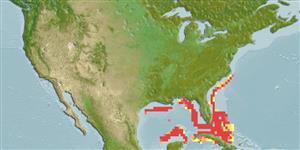Common names from other countries
>
Ophidiiformes (Cusk eels) >
Ophidiidae (Cusk-eels) > Ophidiinae
Etymology: Lepophidium: Latin, lepus, leporis = rabbit + Greek, ophis = serpent (Ref. 45335); crossotum: Name from Greek 'krossotos', meaning fringed, referring to the condition of the snout tip..
Environment: milieu / climate zone / depth range / distribution range
Ecologia
marinhas bentopelágico; intervalo de profundidade 91 - 384 m (Ref. 91765), usually 91 - 192 m (Ref. 91765). Tropical; 36°N - 21°N, 96°W - 75°W (Ref. 91765)
Western Atlantic: along the coast of the US from North Carolina (south of Cape Hatteras) to southern Florida and in the eastern Gulf of Mexico from western Florida to Yucatan.
Tamanho / Peso / Idade
Maturity: Lm ? range ? - ? cm
Max length : 16.8 cm SL macho/indeterminado; (Ref. 91765)
Descrição suscinta
Chaves de identificação | Morfologia | Morfometria
Raios dorsais (total) : 117 - 125; Raios anais : 99 - 106; Vértebras: 68 - 69. This species is characterized by the following: fringed snout; differs from L. kallion and L. wileyi by fewer total vertebrae (67-69 vs. 71-75 and 70-75, respectively) and lateral line length in SL (87.8% vs. 88.8% and 91.5%, respectively); differs from L. kallion in the number of dorsal rays (117-125 vs. 129-137) and anal rays (99-106 vs. 108-114), average post orbital length in HL (48.6% vs. 56%), average orbit diameter in HL (30.9% vs. 25.4%), average body depth at occiput in SL (10.7% vs. 13.3%), at origin of dorsal fin (11.5% vs. 14.5%), at origin of anal fin (10.1% vs. 11.9%), average predorsal distance in SL (22.1% vs. 23.9%), average preanal distance in SL (35.6% vs. 39.6%); head and body color is pale brown and without pattern (Ref. 91765).
Ciclo de vida ou comportamento de acasalamento
Maturities | Reprodução | Spawnings | Egg(s) | Fecundities | Larvas
Robins, C.R., R.H. Robins and M.E. Brown, 2012. A revision of Lepophidium (Teleoastei, Ophidiidae), with descriptions of eight new species. Bulletin of the Florida Museum of Natural History 52(1):1-94. (Ref. 91765)
Status na Lista Vermelha da UICN (Ref. 130435)
CITES (Ref. 128078)
Not Evaluated
Ameaça para os humanos
Harmless
Uso pelos humanos
Ferramentas
Relatórios especiais
Baixar XML
Fontes da internet
Estimates based on models
Preferred temperature (Ref.
115969): 17.5 - 24.4, mean 21.7 (based on 37 cells).
Índice de diversidade filogenética (Ref.
82804): PD
50 = 0.5000 [Uniqueness, from 0.5 = low to 2.0 = high].
Bayesian length-weight: a=0.00102 (0.00046 - 0.00225), b=3.06 (2.88 - 3.24), in cm Total Length, based on all LWR estimates for this body shape (Ref.
93245).
Nível Trófico (Ref.
69278): 3.5 ±0.7 se; based on size and trophs of closest relatives
Resiliência (Ref.
120179): Elevada, tempo mínimo de duplicação da população menor que 15 meses (Preliminary K or Fecundity.).
Fishing Vulnerability (Ref.
59153): Low vulnerability (11 of 100).
